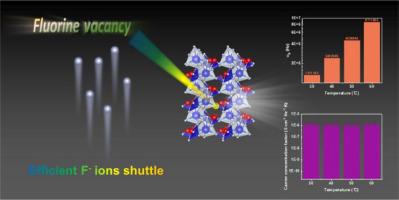当前位置:
X-MOL 学术
›
J. Energy Chem.
›
论文详情
Our official English website, www.x-mol.net, welcomes your feedback! (Note: you will need to create a separate account there.)
Solid-state synthesis and ion transport characteristics of the β-KSbF4 for all-solid-state fluoride-ion batteries
Journal of Energy Chemistry ( IF 13.1 ) Pub Date : 2024-03-27 , DOI: 10.1016/j.jechem.2024.03.027 Jiali Liu , Huahui Zhao , Jingcheng Xia , Lingguang Yi , Xiaoyi Chen , Dongdu Li , Shuhan Ni , Xinyi Su , Yixuan Chen , Min Liu , Xianyou Wang
Journal of Energy Chemistry ( IF 13.1 ) Pub Date : 2024-03-27 , DOI: 10.1016/j.jechem.2024.03.027 Jiali Liu , Huahui Zhao , Jingcheng Xia , Lingguang Yi , Xiaoyi Chen , Dongdu Li , Shuhan Ni , Xinyi Su , Yixuan Chen , Min Liu , Xianyou Wang

|
All-solid-state fluoride ion batteries (FIBs) have been recently considered as a post-lithium-ion battery system due to their high safety and high energy density. Just like all solid-state lithium batteries, the key to the development of FIBs lies in room-temperature electrolytes with high ionic conductivity. -KSbF is a kind of promising solid-state electrolyte for FIBs owing to its rational ionic conductivity and relatively wide electrochemical stability window at room temperature. However, the previous synthesis routes of -KSbF required the use of highly toxic hydrofluoric acid and the ionic conductivity of as-prepared product needs to be further improved. Herein, the -KSbF sample with an ionic conductivity of 1.04 10 S cm (30 °C) is synthesized through the simple solid-state route. In order to account for the high ionic conductivity of the as-synthesized -KSbF, X-ray diffraction (XRD), scanning electron microscopy (SEM), and energy dispersive X-ray spectroscopy (EDS) are used to characterize the physicochemical properties. The results show that the as-synthesized -KSbF exhibits higher carrier concentration of 1.0 10 S cm Hz K and hopping frequency of 1.31 10 Hz at 30 °C due to the formation of the fluorine vacancies. Meanwhile, the hopping frequency shows the same trend as the changes of ionic conductivity with the changes of temperature, while the carrier concentration is found to be almost constant. The two different trends indicate the hopping frequency is mainly responsible for the ionic conduction behavior within -KSbF. Furthermore, the all-solid-state FIBs, in which Ag and Pb PbF are adopted as cathode and anode, and -KSbF as fluoride ion conductor, are capable of reversible charge and discharge. The assembled FIBs show a discharge capacity of 108.4 mA h g at 1st cycle and 74.2 mA h g at 50th cycle. Based on an examination of the capacity decay mechanism, it has been found that deterioration of the electrolyte/electrode interface is an important reason for hindering the commercial application of FIBs. Hence, the in-depth comprehension of the ion transport characteristics in -KSbF and the interpretation of the capacity fading mechanism will be conducive to promoting development of high-performance FIBs.
中文翻译:

全固态氟离子电池β-KSbF4的固态合成及离子传输特性
全固态氟离子电池(FIB)由于其高安全性和高能量密度,最近被认为是后锂离子电池系统。与所有固态锂电池一样,FIB发展的关键在于具有高离子电导率的室温电解质。 -KSbF由于其合理的离子电导率和室温下相对较宽的电化学稳定性窗口,是一种有前途的FIB固态电解质。然而,以往的-KSbF合成路线需要使用剧毒的氢氟酸,且所得产品的离子电导率有待进一步提高。在此,通过简单的固态路线合成了离子电导率为1.04 10 S cm (30 °C)的-KSbF样品。为了解释所合成的-KSbF的高离子电导率,使用X射线衍射(XRD)、扫描电子显微镜(SEM)和能量色散X射线光谱(EDS)来表征其物理化学性质。结果表明,由于氟空位的形成,合成的-KSbF在30°C时表现出较高的载流子浓度(1.0 10 S cm Hz K)和1.31 10 Hz的跳跃频率。同时,跳跃频率随温度的变化与离子电导率的变化趋势相同,而载流子浓度几乎恒定。两种不同的趋势表明跳跃频率主要负责-KSbF内的离子传导行为。此外,采用Ag和Pb PbF作为阴极和阳极,-KSbF作为氟离子导体的全固态FIB能够可逆充电和放电。组装的 FIB 在第 1 次循环时显示出 108.4 mAh g 的放电容量,在第 50 次循环时显示出 74.2 mAh g 的放电容量。基于对容量衰减机制的研究,发现电解质/电极界面的恶化是阻碍FIB商业应用的重要原因。因此,深入理解-KSbF中的离子输运特性和解释容量衰减机制将有助于促进高性能FIB的发展。
更新日期:2024-03-27
中文翻译:

全固态氟离子电池β-KSbF4的固态合成及离子传输特性
全固态氟离子电池(FIB)由于其高安全性和高能量密度,最近被认为是后锂离子电池系统。与所有固态锂电池一样,FIB发展的关键在于具有高离子电导率的室温电解质。 -KSbF由于其合理的离子电导率和室温下相对较宽的电化学稳定性窗口,是一种有前途的FIB固态电解质。然而,以往的-KSbF合成路线需要使用剧毒的氢氟酸,且所得产品的离子电导率有待进一步提高。在此,通过简单的固态路线合成了离子电导率为1.04 10 S cm (30 °C)的-KSbF样品。为了解释所合成的-KSbF的高离子电导率,使用X射线衍射(XRD)、扫描电子显微镜(SEM)和能量色散X射线光谱(EDS)来表征其物理化学性质。结果表明,由于氟空位的形成,合成的-KSbF在30°C时表现出较高的载流子浓度(1.0 10 S cm Hz K)和1.31 10 Hz的跳跃频率。同时,跳跃频率随温度的变化与离子电导率的变化趋势相同,而载流子浓度几乎恒定。两种不同的趋势表明跳跃频率主要负责-KSbF内的离子传导行为。此外,采用Ag和Pb PbF作为阴极和阳极,-KSbF作为氟离子导体的全固态FIB能够可逆充电和放电。组装的 FIB 在第 1 次循环时显示出 108.4 mAh g 的放电容量,在第 50 次循环时显示出 74.2 mAh g 的放电容量。基于对容量衰减机制的研究,发现电解质/电极界面的恶化是阻碍FIB商业应用的重要原因。因此,深入理解-KSbF中的离子输运特性和解释容量衰减机制将有助于促进高性能FIB的发展。



























 京公网安备 11010802027423号
京公网安备 11010802027423号